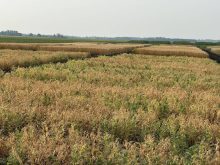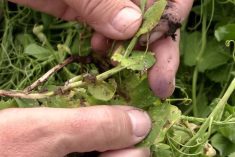Lupins are more common in flower gardens than fields. That could change due to growing attention in Western Canada on pulse development and plant-based protein.
Why it matters: Pulses are a hot commodity given the burgeoning plant-protein market, and that includes new footholds for not-so-familiar crops.
Lupins have been put to the test in crop trials near Souris in the southwest, at the Parkland Crop Diversification Foundation just south of Roblin and in Manitoba’s banana belt near Melita.
Read Also

How much nitrogen can farmers really cut?
Manitoba fertilizer trials look for nitrification inhibitor sweet spot, to lower greenhouse gas emissions and cost without hurting yield.
The Westman Agricultural Diversification Centre this year featured trials set up by Manitoba Agriculture pulse specialist Dennis Lange. Two varieties were tested: blue lupin and sweet white lupin.
Lange turned his attention to lupins after noting farmers’ interest in the crop. Lupins and other legumes were getting a boost from the protein craze and from their ability to fix nitrogen.
Manitoba put significant stock behind its protein advantage strategy (which angles the province as a major source of protein products) and had already seen other pulse crops gain ground. Among those were yellow peas, through global pea protein supplier Roquette.
The national protein supercluster, Protein Industries Canada, announced its focus on plant-based protein, which gave funding to projects featuring various pulses.
One of those projects was a joint venture by Calgary-based Lupin Platform, Hensall Co-op, Lumi Foods and Puris. Last year, $7.3 million in supercluster funds was announced for the four companies to develop lupin varieties, improve processing and develop food products.
Opportunities were knocking.
“If you’re ever going to Winnipeg, and you go to the Bridge Drive-In, they have an ice cream that’s made from lupins,” Lange noted. “Lupin has higher protein content, around 36 per cent versus peas in the 26 per cent range, and that’s part of the reason why there is demand for lupins.”
Another reason is their disease package. In the 2022 edition of the Alberta Seed Guide, Lupin Platform CEO Tristan Choi noted resistance to aphanomyces root rot.

Ancient grain, new again
Lupins came to Canada from Europe, although their agricultural history goes back further. Ancient Egyptians grew and ate lupins. From there, the crop spread throughout the Mediterranean, courtesy of the Romans.
Today, lupins are grown throughout Mediterranean regions as well as northern Europe, Russia and Australia, where they are mainly produced for livestock feed.
A 2021 article by Country Guide noted that about four per cent of the world’s lupins went to human consumption the previous year, although a number of food companies in various parts of Canada had also integrated lupins.
Setting up shop
Lange hadn’t worked with lupins before the trials.
“I had to do a bit of research and that’s something you need to do with a new crop,” he said.
“We really would like to get this into the provincial trials through the Manitoba Pulse [and Soybean] Growers and do a little variety evaluation because there’s still lots to learn with lupins.”
The trials put a number of quirks in full view.
For example, Lange noted, it’s interesting and even comical that blue lupins have a whitish flower and the sweet whites have a bluish tinge.
Potential growers were cautioned against treating lupins like any other pulse.
“If you spray it with Basagran, you’ll kill it. If you spray it with Viper, you’ll kill it,” Lange said. “You’re limited to Edge, or Sencor is another option. You want to start with a relatively clean field.”
Growers with high pH soils should also tread carefully. The test plot in Melita has a pH of 6.8, in the comfortable range for lupins. Sweet white lupins will tolerate up to 7.8, while 7.2 is the limit for blue lupins. Some Red River Valley soils may therefore not be suitable.
The crop likes soil with organic matter around four per cent, and prefers growing on cereal stubble, unless it’s fall rye. Canola ground should be avoided due to lack of weed control options.
“And apparently grasshoppers love lupins,” Lange said. “They did not touch the peas, but they devastated the lupins. And blister beetle is something else that is concerning for lupins as well, so there are some insect issues that you have to deal with.”
Side by side
The next big question is yield. Do they yield better than other pea or bean crops?
“They don’t,” Lange said. “We’re going to say it right off the hop. We’re not going to try to fool you here. They just don’t. With some of the other data I’ve seen on this, if you’re looking at pea yields from the 80- to 90-bushel range, you’re probably looking at 40 to 50 in the lupins.”
They may have aphanomyces resistance but they’re susceptible to other diseases. Like soybeans, lupins are likely to develop iron deficiency chlorosis. They are bothered by anthracnose, but it’s not the same disease strain that affects lentils, peas and dry beans.
“They are susceptible to white mould but there are some options for chemical control in that,” Lange said, adding that lack of vulnerability to aphanomyces makes them “a good crop to include in a break year.”
That’s good news for pea growers. Since lupins won’t incubate aphanomyces, growers could get another pulse into a pea rotation and give aphanomyces inoculum another year to die out.
“There are some other concerns that you have to be aware of, because you don’t want contamination of lupin with a pea because of food allergy concerns with the peas,” Lange said.
“You also don’t want to have soybean volunteering, so I use the rule of two years. We need two full years from a soybean or another pulse crop before you put another pulse back in. If you have soybean in year one and a cereal in year two, you don’t want to have peas or beans in year three. Put another cereal or something else in there.”
Lupins take a little longer than peas to mature. Lange expects about 114 days, with the blue lupins maturing a little sooner than sweet whites.
“Pod shattering can be a bit of a concern and, at harvesting, they’re talking about slow cylinder speeds,” Lange said. “Run at about four to 600 RPMs, pretty slow cylinder speeds because of the size of the seed.”
Past trials in northwestern Manitoba have shown mixed results. An article published in the Co-operator last year noted that lupins were on the roster of the Parkland Crop Diversification Foundation for several seasons.
“In some years we’ve had great success growing it. In other years we have had literally no plants coming up,” James Frey, an applied research specialist at the site, said at the time.
He suspected some of those difficulties were due to seeding rate.















